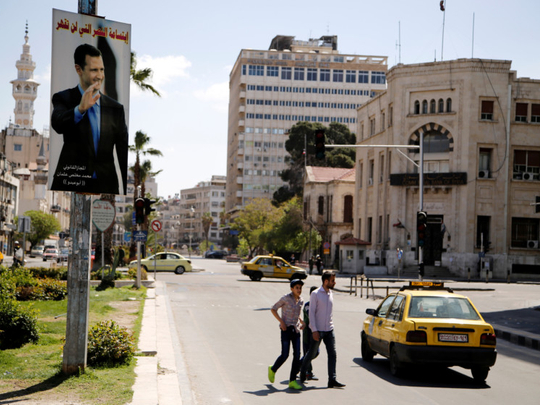
Damascus: Manifestations of anti-Americanism are almost invisible on the streets of Damascus, despite an unprecedented American air strike on a Syrian airbase near the ancient city of Homs on April 7.
The ruling Baath Party, which was celebrating its 70th anniversary the same day, has not said a word, and no anti-American demonstrations have since been staged, which was a common scene in Syria in previous years.
To protest American ‘adventurism’ in the past, the Syrian regime held ostentatious anti-American rallies where Baath Party leaders often gave fiery speeches and protesters burnt American flags and pictures of US presidents.
In December 1998, Syrians took to the street when the US bombed Iraq, despite the fact that at that time they enjoyed warm relations with then-president Bill Clinton. The current silence has observers scratching their heads. There were no disturbances near the now-closed US embassy in the posh neighbourhood of Al Rawda in Damascus or at the American school in the posh Abu Rummaneh district.
Students were not given a day-off from school and called to the streets to protest, and no photos of the US president were torched or stomped upon.
State-run television did not interrupt its regular broadcasts to cover the strike, and only mentioned it after world media picked up the story.
Communists, Baathists, and Arab nationalists with a historic axe to grind with the United States were not called into Syrian TV’s studios to comment on the developments.
US-linked commercial establishments still operating in Damascus were not vandalised.
While regime supporters called the strikes “rash and unwise” they did not trash US President Donald Trump, who they had pinned their hopes on to champion a ‘hands-off’ approach in Syria.
Only a few days before the strike, they gloated over statements made by American officials saying that regime change was no longer a priority for the United States.
Secretary of State Rex Tillerson said that Bashar Al Assad’s “long-term” future was up to the Syrian people to decide, without calling on him to step down, while White House Spokesman Sean Spicer added that Al Assad’s rule in Syria was a “political reality” that the world had to accept.
Since the strike, however, American officials have toughened their rhetoric, with some officials saying Al Assad should step down and Tillerson saying that his rule was coming to end.
Khalil Al Hassan, a sophomore student at a private university in Damascus, with ties to the Syrian Communist Party, said he received no orders to come out and protest.
“We are relying on Russia and Iran to convey our voice to Washington,” regime official Samira Mustafa, told Gulf News when asked to explain the regime’s muted response. Instead of a Syrian government, the Joint Syrian-Russian-Iranian Command came out with statement saying that the US “waged aggression on Syria” and crossed “redlines.”
The statement added: From now on we will respond with force to any aggressor or any break … and America knows our ability to respond well.”
Still, like many others around the world, the US strike confused Syrians, who struggled to come up with a logical reason for why it was carried out.
“Where was Russia and Iran when this happened?” Raef Al Homsi, a barber in Damascus, asked.
Despite significant Russian and Iranian military presence in the country, the two countries had no men at the Homs base at the time of the attack, leading many to question America’s true objectives.












